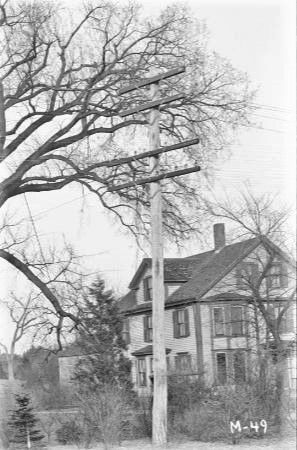Central MA, 1925. Electric Utility Pole with Telephone Subscriber Lines.
By Joe Maurath, Jr.; posted November 27, 2020
View Original: Click to zoom, then click to magnify (297 x 450) 77KB

|
The 10-pin crossarm construction style seen here was seen all over New England Telephone and Telegraph Company's subscriber lines. I very fondly recall many single and double-crossarm lines just like this one. They were subscriber circuits along some of the side streets in the city I grew up in (Brockton, MA) with the electric utility's stuff above. Starting around 1963 the phone company started to convert what they had left of these runs to paired cable. By 1967 they were pretty well done with this project in my hometown. The New England Telephone Company yard was nearby and I was welcome to whatever insulators they had in their pile. Most were CD 121 Brookfields and Hemingrays with plenty of CD 154s of common types along with some CD 115s, 122s, 155s, 203s, etc. Of the hundreds of insulators I sifted through there were wasn't a solitary CD 102, 104, 106 or 112. These were what Ma Bell regarded as "pony" styles and per their directives through the years, were to be taken out of service whenever and wherever encountered. That is unfortunate since Brockton was one of the larger communities that the Southern Massachusetts Telephone Company served. Otherwise I am sure there would have been a good number of their CD 102 ponies among my finds.. The crossarms used were creosote, heavy duty and designed to last virtually forever. Same with the pins. An alunimum NET&T Co. pole tag always was between the crossarms' center and end. Most of these arms were salvaged as they were taken down and given away in the 1960s and were used for building fences, sheds, etc. These crossarms utilized 30-inch galvanized steel braces mounted over the outside of their arms. The wire was galvanized, often with little rust. When NET&T took over Southern Massachusetts Telephone in 1938 I believe most of their former lines were rebuilt including new wire, crossarms and with Bell-approved (non-pony) insulators. Click "Next" for a close view of this poles upper section. |